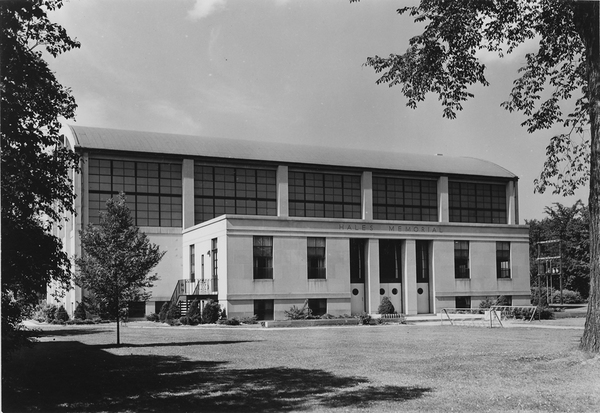Hales Memorial Gymnasium
Date
1939-presentLocation
180 West Lorain StreetArchitects/Collaborators
Richard A. Kimball (1899-1997), New York City (architect)John Gill & Sons Co., Cleveland (contractors)
1958 Annex: Visnapu & Gaede, Cleveland (architects)
Style
Modernistic
History
The funds for Hales Memorial Gymnasium were given by G. Willard Hales (OC 1900) in memory of his mother, Lina Rosa Hales. It was the first modern gymnasium for women at Oberlin, succeeding several makeshift structures that served multiple purposes (see Women's Gymnasium Second). Men had enjoyed the use of Warner Gymnasium since 1901; it was enlarged in 1912. Women had been using Crane Pool, adjoining Hales Gym, since it opened in 1931. The 1939 gym was designed by Richard A. Kimball to complement the design of Crane Pool. Kimball had designed the Co-Education Centennial Memorial Gateway in 1937. The Hales Gym Annex, designed by Oberlin graduate Herk Visnapu, opened in 1958. It served the Department of Zoology after the demolition of Wright Zoological Laboratory that year. The bowling lanes were installed in 1963, replacing those in Wilder Hall. The Kettering Hall of Science, opened in 1971, absorbed science uses out of Hales. With the opening of Philips Gymnasium in 1971 and coeducation arrived in physical education, the bulk of the women's program migrated to the new facility.Today Hales Gymnasium offeres recreational and physical education opportunities to both men and women. It features a gym with one basketball court used for a variety of group sports and exercise classes. The facility also has classrooms, offices, locker rooms, and showers. The gym's multiuse wood floor accommodates recreational play in basketball, volleyball, badminton, and indoor baseball as well as physical education, yoga, and fitness classes. Hales Annex now houses the Cat in the Cream Coffeehouse that offers space for solo and small ensemble jazz performances that draw appreciative audiences. The complex once housed the acclaimed Jazz Studies Program, and the music theory and music history departments, which, in spring 2010, relocated to the new Bertram and Judith Kohl Building at the Conservatory of Music.
Sources
Geoffrey Blodgett, Oberlin Architecture, College and Town: A Guide to Its Social History (Oberlin, OH: Oberlin College, 1985), 32-33.
Oberlin College Archives, Office of the Secretary Records.
Oberlin College Website, Facilty Detail, Hales Gymnasium accessed May 15, 2015.
Geolocation
Image Description
Black and white, gelatin silver 6.45 x 9.36 in. vintage print, ca. 1940
(© Oberlin College Archives, RG 32/4)

